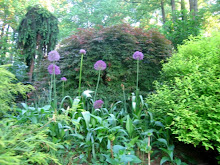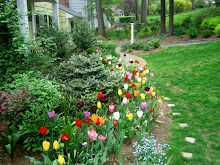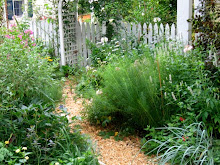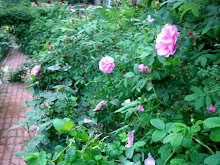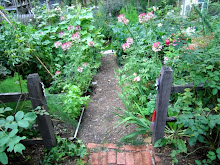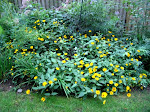This month's Garden Bloggers' Design Workshop at Gardening Gone Wild is on Labeling and Record Keeping. Like many of the other bloggers, I have tried many different methods of labeling and record keeping with varying degrees of success over the years. For example, I tried the wooden and metal markers, but I didn't like how they looked in the garden, so I no longer use them. In recent years, I have settled on three means of record keeping: the Garden Journal, the Garden Planning Binder, and the photographs of my garden.
~
In terms of the Garden Journal, I wrote a separate post about it last year that I won't repeat in full here: "I find the garden journal is an invaluable tool to help me keep track of my garden and plan for the future. I started keeping a garden journal about six years ago. Before then, I would keep notes at random on successes, failures, and sources of inspiration. These I would easily misplace and forget about."
~
I used to try to keep track of absolutely everything in my Garden Journal, but one aspect of my record keeping kept slipping through the cracks: what plants I had ordered, where I planned to plant them, and what I still needed to buy. I would print out my online orders and put them in a file folder to read alongside my Garden Journal, but it was just too disorganized. Boxes of plants that I had ordered in the fall and winter would arrive on my doorstep in the spring and I would forget why I had ordered such and such a plant and/or where I planned to plant it. Sometimes I would remember the space I was trying to fill, but other times I would not and need to find a home for it. At some point later in the season, the intended space would present itself and I'd remember what I had planned to plant there, causing me to move the plant or change the plan.
~
My Garden Journal needed a friend. Thus, the Garden Planning Binder was born. I bought a large three-ring binder and anytime I ordered anything--trees, shrubs, bulbs, perennials, annuals--I would print out the order form, write down where I planned to plant it, punch holes in it, and put it in the binder. This works on purchases for my containers, as well as my beds. Also, by keeping all of the receipts together, I am better able to keep track of my budget. Now, when the boxes arrive in the spring, I just find the matching order in the Garden Planning Binder and immediately plant the plants where they are supposed to go.
***
One unrelated note about labeling dahlia tubers. If you over-winter dahlia tubers, here is one specific record-keeping suggestion: write the name of the dahlia on the actual tuber with a black Sharpie marker. I used to keep them in paper bags with the name of the dahlia on the bag, but I found that the paper bag disintegrated by the next spring.
Welcome to Heirloom Gardener
Monday, January 26, 2009
How to Keep Track of What Plants You Have Bought, Where They are Going, and What You Still Need to Buy: The Garden Planning Binder
Posted by
Julia Erickson
at
5:47 PM
6
comments
![]()
![]()
Labels: Garden Bloggers' Design Workshop, Pruning and Maintenance
Thursday, January 22, 2009
Hydrangea paniculata in the snow
Posted by
Julia Erickson
at
6:00 AM
2
comments
![]()
![]()
Labels: Hydrangeas, Winter Garden
Tuesday, January 20, 2009
Organic Pest and Fungus Control: Garlic Barrier - Yes, It Really Works

Posted by
Julia Erickson
at
7:22 PM
7
comments
![]()
![]()
Labels: Pest Control
Monday, January 19, 2009
Annabelle Hydrangea in the Snow
Posted by
Julia Erickson
at
9:30 PM
3
comments
![]()
![]()
Labels: Hydrangeas, Winter Garden
Thursday, January 15, 2009
Garden Bloggers' Bloom Day, January 2009: Snowdrops in the Snow!

Posted by
Julia Erickson
at
6:00 AM
16
comments
![]()
![]()
Labels: Bulbs and Tubers, Garden Bloggers' Bloom Day, Winter Garden
Tuesday, January 13, 2009
Second Amaryllis in Bloom (White)

Posted by
Julia Erickson
at
12:04 AM
4
comments
![]()
![]()
Labels: Bulbs and Tubers, Cut and Forced Flowers
Wednesday, January 07, 2009
Baker Creek Heirloom Seeds: the best heirloom seed offerings I've seen anywhere
I recently received my Baker Creek Heirloom Seeds catalog. I love it. The whole thing deserves a cover to cover read. The heirloom seed offerings are phenomenal--the best I've seen anywhere. The descriptions and histories of the various seeds are interesting and illuminating. For instance, I'd never heard of some of the cucumbers offered, particularly those from India. There are cucumbers in many colors: white, yellow, green, and even brown.
~
The seed selection is vast and diverse. They have so many of my favorite black and green tomatoes that I was out in the garden looking for more places to grow tomatoes. The catalog notes that Baker Creek offers more melons than any other catalog. I was happy to find a 60 day maturing watermelon. Also, you will not find any GMOs in this catalog, not even GMO corn.
~
The story of Baker Creek and the company's aims are also to be applauded. It is a family owned business from Missouri (my home state) which has been able to grow every year in size and offerings. In the back of the catalog is a reprint of an article about the founder, Jeremiath Gettle. I love the story of how his love of heirloom vegetables and seed saving has grown into a thriving business. This is truly a story of how following you passion can reap vast personal rewards.
~
In addition to offering seeds for sale, Baker Creek also publishes a magazine (with a great name) "The Heirloom Gardener;" has a poultry farm for historic, rare breed chickens; and hosts several festivals at Bakersville, the historical village they are creating.
~
For more information, check out their websites:
http://rareseeds.com/
http://heirloomseedsmen.com/
http://theheirloomgardener.com/ (no relation to this blog)
Posted by
Julia Erickson
at
4:57 PM
10
comments
![]()
![]()
Labels: Heirloom and Organic Food, Nurseries
Government Gone Wild: Proposed Greenhouse Gas Emissions Tax on Cows and Other Livestock
From the New York Times: The E.P.A. indeed issued an “advanced notice of proposed rulemaking” this summer that called for public comments on the idea of regulating greenhouse gas emissions from cars, as well as “stationary sources” — which, yes, would include cows and other livestock. For the full article, click here.
Posted by
Julia Erickson
at
8:27 AM
2
comments
![]()
![]()
Labels: Heirloom and Organic Food
Sunday, January 04, 2009
First Amaryllis in Bloom (Red)

Posted by
Julia Erickson
at
6:39 PM
4
comments
![]()
![]()
Labels: Bulbs and Tubers, Cut and Forced Flowers
Saturday, January 03, 2009
Hydrangeas in the Snow
Posted by
Julia Erickson
at
7:47 AM
4
comments
![]()
![]()
Labels: Hydrangeas, Winter Garden
Friday, January 02, 2009
Local Harvest: North Jersey Farms, Food and Families

Frelinghuysen Arboretum
Saturday, January 17, 2009 (snow date January 24), 1-4 p.m.
Free admission
Meet some of the New Jersey farmers and artisans who produce the food on your table at “Local Harvest: North Jersey Farms, Food, and Families,” a celebration of the farms of northern New Jersey. Meet farmers, watch chef demos, sample and purchase local food, and learn about north Jersey’s agricultural heritage past and present. Learn about CSA (Community Supported Agriculture) and sign up for a share of the 2009 harvest. Co-sponsored by the Morris County Historical Society and the Northern New Jersey chapter of Slow Food USA.
Made possible by a grant from the New Jersey Council for the Humanities, a state partner of the National Endowment for the Humanities.
More details: http://www.acornhall.org/events.htm
Posted by
Julia Erickson
at
8:23 PM
0
comments
![]()
![]()
Labels: New Jersey / Local Interest
Thursday, January 01, 2009
Some Christmas Presents for the Gardener (Received)
Posted by
Julia Erickson
at
7:28 PM
3
comments
![]()
![]()
Labels: Holidays
Search Heirloom Gardener
Labels
- About Blogging
- Annuals/Biennials and Perennials
- Autumn Garden
- Books and Movies
- Botanical Gardens
- Bulbs and Tubers
- Children's Garden
- Chrysanthemum
- Clematis
- Container Gardening
- Crocus tommasiniasus roseus
- Cut and Forced Flowers
- Cutting and Rose Gardens
- Dahlias
- Deep Thoughts About Gardening
- Egg Garden
- Fences Arbors Walls and Paths
- Floral arrangements
- Front Border
- Fun Stories About Gardening
- Garden Bloggers' Bloom Day
- Garden Bloggers' Design Workshop
- Garden Planning
- Gardening Blogs
- Gardening Tools and Structures
- Gardening with Children
- Goldberry Hill
- Heirloom and Organic Food
- Hibiscus
- Holidays
- Hydrangeas
- Japanese Beautyberry
- Lilies
- Mixed Borders
- New Jersey / Local Interest
- Nurseries
- Online Gardening Resources
- Peonies
- Pest Control
- Picture This Photo Contest
- Piet Oudolf
- Poppies
- Propagation and Seeds
- Pruning and Maintenance
- Roses
- Seed Heads
- Self Seeders
- Shrubs
- Spring Garden
- Summer Garden
- Trees
- Wildlife in the Garden
- Winter Garden
- Zinia
Blog Archive
-
▼
2009
(257)
-
▼
January
(12)
- How to Keep Track of What Plants You Have Bought, ...
- Hydrangea paniculata in the snow
- Organic Pest and Fungus Control: Garlic Barrier -...
- Annabelle Hydrangea in the Snow
- Garden Bloggers' Bloom Day, January 2009: Snowdro...
- Second Amaryllis in Bloom (White)
- Baker Creek Heirloom Seeds: the best heirloom see...
- Government Gone Wild: Proposed Greenhouse Gas Emi...
- First Amaryllis in Bloom (Red)
- Hydrangeas in the Snow
- Local Harvest: North Jersey Farms, Food and Families
- Some Christmas Presents for the Gardener (Received)
-
▼
January
(12)


















